Related Research Articles
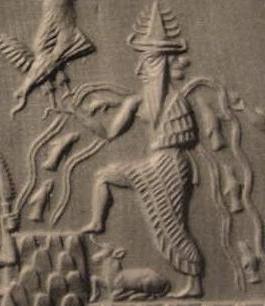
Enki is the Sumerian god of water, knowledge (gestú), crafts (gašam), and creation (nudimmud), and one of the Anunnaki. He was later known as Ea or Ae in Akkadian (Assyrian-Babylonian) religion, and is identified by some scholars with Ia in Canaanite religion. The name was rendered Aos in Greek sources.

The Kingdom of Judah was a Semitic-speaking kingdom of the Southern Levant during the Iron Age. Centered in the highlands of Judea, the kingdom's capital was Jerusalem. Jews are named after Judah and are primarily descended from it.
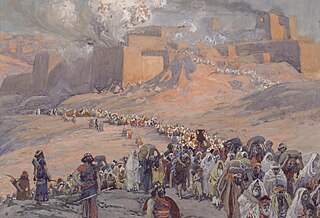
The Babylonian captivity or Babylonian exile is the period in Jewish history during which a large number of Judeans from the ancient Kingdom of Judah were captives in Babylon, the capital city of the Neo-Babylonian Empire, following their defeat in the Jewish–Babylonian War and the destruction of Solomon's Temple in Jerusalem. The event is described in the Hebrew Bible, and its historicity is supported by archaeological and extra-biblical evidence.

Inanna is an ancient Mesopotamian goddess of love, war, and fertility. She is also associated with beauty, sex, divine law, and political power. She was known by the Sumerians and Akkadians, Babylonians, and Assyrians as Ishtar. Her primary title was "the Queen of Heaven", and she was the patron goddess of the Eanna temple at the city of Uruk, which was her early main cult center. In archaic Uruk she was worshiped in three forms, morning Inanna (Inana-UD/hud), evening Inanna and princely Inanna, the former two reflecting the phases of the planet Venus which she was associated with. Her most prominent symbols included the lion and the eight-pointed star. Her husband was the god Dumuzid, and her sukkal, or personal attendant, was the goddess Ninshubur,.

Uruk, today known as Warka, was an ancient city of Sumer situated east of the present bed of the Euphrates River on the dried-up ancient channel of the Euphrates 30 km (19 mi) east of modern Samawah, Al-Muthannā, Iraq.

Bêl is a title signifying "lord" or "master" applied to various gods in the Mesopotamian religion of Akkad, Assyria, and Babylonia. The feminine form is Bêlit in Akkadian. Bel is represented in Greek as Belos and in Latin as Belus. Belit appears in Greek form as Beltis (Βελτις). Linguistically, Bel is an East Semitic form cognate with the Northwest Semitic Baal with the same meaning.
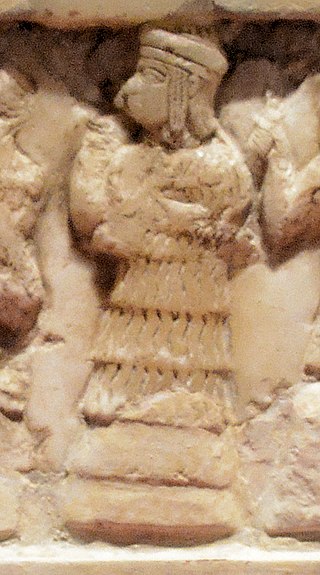
Enheduanna was the entu (high) priestess of the moon god Nanna (Sīn) in the Sumerian city-state of Ur in the reign of her father, Sargon of Akkad. She was likely appointed by her father as the leader of the religious cult at Ur to cement ties between the Akkadian religion of her father and the native Sumerian religion.
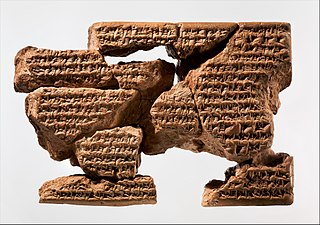
Sîn-šar-iškun was the penultimate king of Assyria, reigning from the death of his brother and predecessor Aššur-etil-ilāni in 627 BC to his own death at the Fall of Nineveh in 612 BC.
Aššur-etil-ilāni, also spelled Ashur-etel-ilani and Ashuretillilani, was the king of the Neo-Assyrian Empire from the death of his father Ashurbanipal in 631 BC to his own death in 627 BC. Aššur-etil-ilāni is an obscure figure with a brief reign from which few inscriptions survive. Because of this lack of sources, very little concrete information about the king and his reign can be deduced.

Sîn-šumu-līšir or Sîn-šumu-lēšir, also spelled Sin-shum-lishir, was a usurper king in the Neo-Assyrian Empire, ruling some cities in northern Babylonia for three months in 626 BC during a revolt against the rule of the king Sîn-šar-iškun. He was the only eunuch to ever claim the throne of Assyria.

The Burney Relief is a Mesopotamian terracotta plaque in high relief of the Isin-Larsa period or Old-Babylonian period, depicting a winged, nude, goddess-like figure with bird's talons, flanked by owls, and perched upon two lions.
Ninegal or Belat Ekalli (Belet-ekalli) was a Mesopotamian goddess associated with palaces. Both her Sumerian and Akkadian name mean "lady of the palace."

Dilbat was an ancient Sumerian minor tell located southeast from Babylon on the eastern bank of the Western Euphrates in modern-day Al-Qādisiyyah, Iraq. The ziggurat E-ibe-Anu, dedicated to Urash, a minor local deity distinct from the earth goddess Urash, was located in the center of the city and was mentioned in the Epic of Gilgamesh.
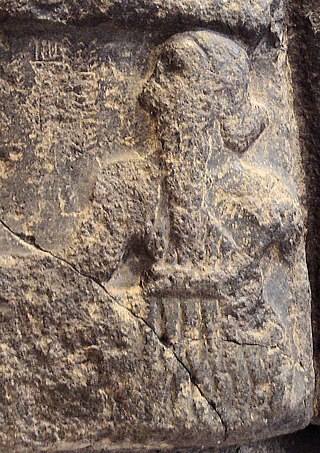
Sargon of Akkad, also known as Sargon the Great, was the first ruler of the Akkadian Empire, known for his conquests of the Sumerian city-states in the 24th to 23rd centuries BC. He is sometimes identified as the first person in recorded history to rule over an empire.

Anu or Anum, originally An, was the divine personification of the sky, King of the gods, and ancestor of many of the deities in ancient Mesopotamian religion. He was regarded as a source of both divine and human kingship, and opens the enumerations of deities in many Mesopotamian texts. At the same time, his role was largely passive, and he was not commonly worshiped. It is sometimes proposed that the Eanna temple located in Uruk originally belonged to him, rather than Inanna, but while he is well attested as one of its divine inhabitants, there is no evidence that the main deity of the temple ever changed, and Inanna was already associated with it in the earliest sources. After it declined, a new theological system developed in the same city under Seleucid rule, resulting in Anu being redefined as an active deity. As a result he was actively worshiped by inhabitants of the city in the final centuries of history of ancient Mesopotamia.
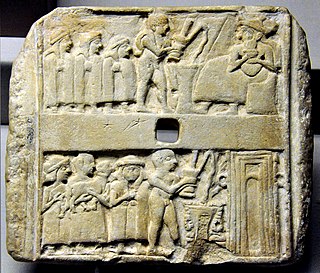
Sumerian religion was the religion practiced by the people of Sumer, the first literate civilization of ancient Mesopotamia. The Sumerians regarded their divinities as responsible for all matters pertaining to the natural and social orders.

The Kesh temple hymn, Liturgy to Nintud, or Liturgy to Nintud on the creation of man and woman, is a Sumerian tablet, written on clay tablets as early as 2600 BCE. Along with the Instructions of Shuruppak, it is the oldest surviving literature in the world.

Enamtila is a Sumerian term meaning "house of life" or possibly "house of creation". It was a sanctuary dedicated to Enlil, likely to have been located within the Ekur at Nippur during the Akkadian Empire. It also referred to various other temples including those to later versions of Enlil; Marduk and Bel as well as one to Ea. It was likely another name for Ehursag, a temple dedicated to Shulgi in Ur. A hymn to Nanna suggests the link "To Ehursag, the house of the king, to the Enamtila of prince Shulgi we go!" Another reference in the Inanna - Dunmuzi text translated by Samuel Noah Kramer references the king's palace by this name and possibly makes references to the "sacred marriage": "In the Enamtila, the house of the king, his wife dwelt with him in joy, in the Enamtila, the house of the king, Inanna dwelt with him in joy. Inanna, rejoicing in his house ...". A fire is reported to have broken out next to the Enamtila in a Babylonian astronomical diary dated to the third century BC. The Enamtila is also referred to as a palace of Ibbi-Sin at Ur in the Lament for Sumer and Ur, "Its king sat immobilised in his own palace. Ibbi-Suen was sitting in anguish in his own palace. In E-namtila, his place of delight, he wept bitterly. The flood dashing a hoe on the ground was levelling everything."

Inanna of Zabalam was a hypostasis of the Mesopotamian goddess Inanna associated with the city of Zabalam. It has been proposed that she was initially a separate deity, perhaps known under the name Nin-UM, who came to be absorbed by the goddess of Uruk at some point in the prehistory of Mesopotamia and lost her unknown original character in the process, though in certain contexts she nonetheless could still be treated as distinct. She was regarded as the mother of Shara, the god of Umma, a city located near Zabalam.
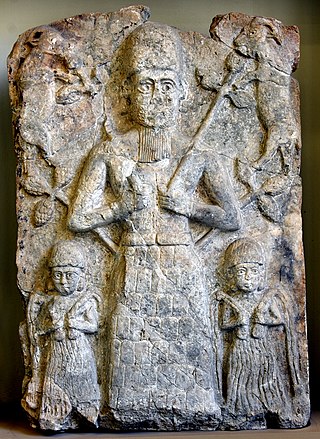
Ebiḫ (Ebih) was a Mesopotamian god presumed to represent the Hamrin Mountains. It has been suggested that while such an approach was not the norm in Mesopotamian religion, no difference existed between the deity and the associated location in his case. It is possible that he was depicted either in a non-anthropomorphic or only partially anthropomorphic form. He appears in theophoric names from the Diyala area, Nuzi and Mari from between the Early Dynastic and Old Babylonian periods, and in later Middle Assyrian ones from Assyria. He was also actively venerated in Assur in the Neo-Assyrian period, and appears in a number of royal Tākultu rituals both as a mountain and as a personified deity.
References
- ↑ Patricia Monaghan (18 December 2009). Encyclopedia of Goddesses and Heroines. ABC-CLIO. pp. 63–. ISBN 978-0-313-34989-8 . Retrieved 2 June 2011.
- ↑ Society of Biblical Archæology (London, England) (1911). Proceedings of the Society of Biblical Archaeology, Volume 33, Pl. XI. Society of Biblical Archæology.
- ↑ Babylonian liturgies: Sumerian texts from the early period and from the library of Ashurbanipal, p. 87. Geushner. 1913. Retrieved 2 June 2011.